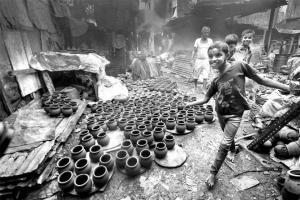The biggest slum in southern Asia has been the background for some movies but those that had missed its collective sentiment, which Rajinikanth's latest blockbuster Kaala talks about

Representational Image
 Dharavi continues to fascinate. The biggest slum in southern Asia has been the background for some movies but those that had missed its collective sentiment, which Rajinikanth's latest blockbuster Kaala talks about. The film makes a definite statement in the context of Dharavi's much controversial redevelopment plan that has been pushed ahead by successive governments, builder lobbies, bureaucrats and political parties in a manner that the majority of residents don't approve of.
Dharavi continues to fascinate. The biggest slum in southern Asia has been the background for some movies but those that had missed its collective sentiment, which Rajinikanth's latest blockbuster Kaala talks about. The film makes a definite statement in the context of Dharavi's much controversial redevelopment plan that has been pushed ahead by successive governments, builder lobbies, bureaucrats and political parties in a manner that the majority of residents don't approve of.
Kaala is a complete package, exceedingly overt in talking how politics affects the economy and sociology of Dharavi. Tactics are used by select insiders and outsiders to disturb the harmony of one of the largest conglomerates of Dalits and minorities.
ADVERTISEMENT
On-screen drama
Kaala is the second generation son of a Tamil migrant family, which has fought slumlords and land-grabbers to stay put. He is a respected 60-year-old, not interested in becoming a neta, but plays a peaceful kingmaker. He ensures that a goonda-turned-politician is defeated from Dharavi when his party grabs power in the state.
Symbolism plays here in targeting a party that is upset over migrants' influx in the city. The same party had envisaged Dharavi's redevelopment, which later exchanged many hands and parties, but without any great success. A pilot project stands alone, as schemes after schemes have failed on paper and in practice.
Like Dharavi's Gen Next, who have found a footing beyond the locality by way of higher education, Kaala's sons are fed up with sub-human living conditions and want their financially stable family to move to a plush residential area. This resonates with a dream of earning well and living a quality life. But the father refuses, saying they are what they are only because of Dharavi's parental existence.
His youngest son, an activist aptly named after Russian revolutionary Vladimir Lenin, defies him and leaves home for getting residents better and bigger homes through a redevelopment scheme Kaala is opposed to. As they say, 'divide and rule', a builder-turned-politician, who wants a 'Pure Mumbai' by way of cleaning the dung called Dharavi off the metro, joins hands with Lenin.
The film ends as expected with some cinematic liberty and Rajini-style action-drama, and yet it poses questions that haven't been answered in the corridors of power. This makes Kaala one of the most relevant political movies in a truly urban context.
Rajini, from reel to real
One cannot stop thinking if Kaala should be seen as Rajini the political leader's agenda in the days to come. Director-writer Pa Ranjith, who earlier experimented with the political genre via Kabali, establishes Rajini's image as the messiah of the downtrodden through Kaala. He connects Dharavi's problems to those faced by slums in other metros. He emphasises on raising the voice of Dalits, minorities, non-privileged and under-privileged people with the backdrop of a slum, which is nothing but a smaller version of India, where people of various castes, creed and religion live and power Mumbai through their hard work.
Kaala goes beyond a Dharavi rhetoric of filth, poverty and crime that filmmakers from Bollywood and Hollywood have been showing. Rajini's film doesn't appear a tourism walkthrough that professionals have been promoting in Dharavi. It makes sensible viewers think about the cosmopolitan jhuggi janata's demand for the right to live with dignity and without any interference from the people who have set their eyes on the land their forefathers made livable.
Viewers are made to understand the politics of redevelopment, the area of prime interest to the builders, politicians, bureaucrats, police officers and slumlords.
When I exited the multiplex, recollecting images of the Dharavi I have covered extensively, a question kept nagging: if outsiders like Rajini and Ranjith could make it into a stunning film, did Bollywood's best brains ever think of attempting it?
Dharmendra Jore is political editor, mid-day. He tweets @dharmendrajore Send your feedback to mailbag@mid-day.com
Catch up on all the latest Mumbai news, crime news, current affairs, and also a complete guide on Mumbai from food to things to do and events across the city here. Also download the new mid-day Android and iOS apps to get latest updates
 Subscribe today by clicking the link and stay updated with the latest news!" Click here!
Subscribe today by clicking the link and stay updated with the latest news!" Click here!







